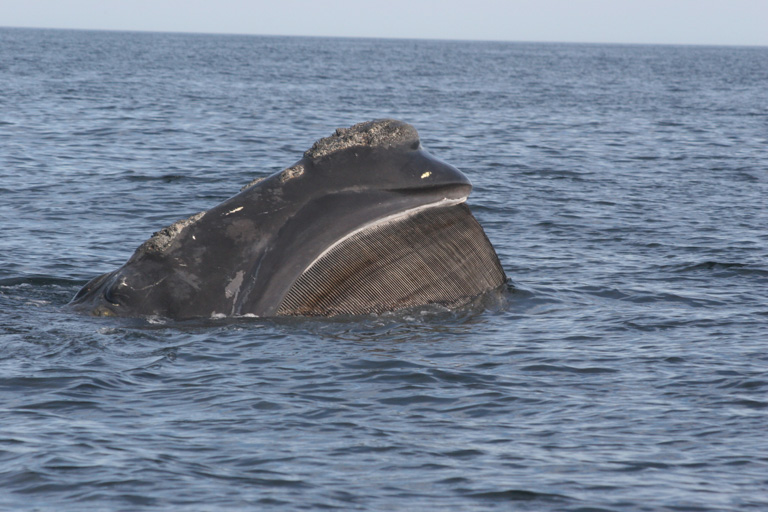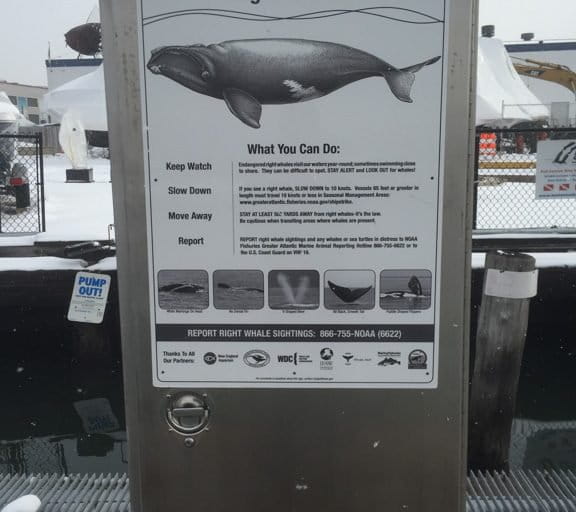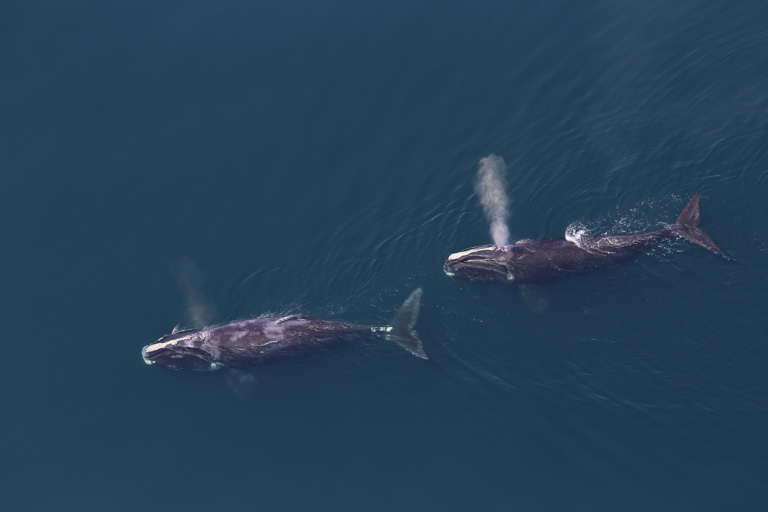- Just 451 North Atlantic right whales remain, down from 458 in 2016 and 483 in 2010.
- Entanglements in fishing gear and ship strikes remain the two most important threats to right whale survival.
- A study published in November in the journal Ecology and Evolution finds that fewer females are surviving than males and the interval between calving is growing longer.
It’s been a rough year for North Atlantic right whales. Fifteen died in the first 10 months of the year, concerning scientists enough that the National Oceanic and Atmospheric Administration declared this past summer an “unusual mortality event.” And recently, a team of scientists reported that this year is part of a longer decline over the past several years.
Critically, female right whales are struggling to reproduce, the study found.
“They’re dying too young, and they’re not having calves often enough,” said ecologist Peter Corkeron of NOAA’s Northeast Fisheries Center in Woods Hole, Mass., at the North Atlantic Right Whale Consortium annual meeting in Nova Scotia in October. Corkeron is one of the paper’s authors.

Marine mammal scientists have long identified the two main threats to the North Atlantic right whale (Eubalaena glacialis), an IUCN-listed Endangered species: getting hit by massive cargo ships, and getting snared in the ubiquitous fishing gear found off the eastern coast of Canada and the United States. Prior to those issues, the species had been decimated by centuries of hunting; as slow-moving whales that bobbed to the surface once dispatched, they were the “right” whales to kill, and by 1990 the population had dropped to just 270 animals.
Twenty years of research and strategies to keep more whales alive buoyed the population to 483 in 2010. But the current study, published in the November issue of the journal Ecology and Evolution, confirms what scientists in the field have observed in the past decade: that right whale numbers are trending down. Employing a unique method of modeling, the team found with near-100 percent certainty that there were 458 animals in 2015. The current estimate: 451 North Atlantic right whales.
“Although our work directly reveals a relatively small decrease, the subtext is that this species is presently in dire straits,” Richard Pace, a biologist at the Northeast Fisheries Center who is also the lead author of the report, said in a statement.
The study also uncovered another worrisome trend: Female right whales are dying faster than males, further complicating an already difficult road to recovery.
When it comes to increasing the number of individual animals, Corkeron said, “What really matters is the number of females in a species.”
A female whale must sustain herself and a fetus throughout a 12-month pregnancy, and she has to protect and feed an infant that can be 4.5 meters (15 feet) long and weigh 900 kilograms (1 ton) at birth. A population that is hemorrhaging females could help create what Scott Kraus, a biologist at the New England Aquarium in Boston, calls the “cliff of reproduction” that scientists have observed since 2010.
“There are two explanations for this where there’s solid scientific evidence,” said Kraus, one of the study’s coauthors, at the October event.
It could be that the females are not getting enough to eat because their prey — the tons of krill and zooplankton that they rely on — isn’t in the same place that it used to be, or the whales can’t find it in adequate amounts to support their own enormity.
For potential right whale mothers, “You got to be fat to have babies,” Kraus said.
Another, more insidious possibility is that tangling with fishing gear causes enough problems, whether from the drag that toting the gear around causes or the injuries inflicted, to keep whales from bulking up and breeding the way they have in the past.
Kraus said they expect a breeding-age female to have a calf every three to six years. But a recent report card on North Atlantic right whales recorded an average of more than 10 years between calves for the five females who gave birth in 2017.

At the same time, few right whales remain untouched by gear entanglements.
“It’s such a common event for right whales and all of them are suffering from a certain amount of damage,” Kraus said. “It’s very likely to have a substantial impact on reproduction over time.”
If that weren’t bad enough, in July a rescuer trained to remove entangled fishing gear that seems to be hindering the animal’s recovery was killed while trying to cut a whale free in Canada’s Gulf of St. Lawrence.
For male whales, an entanglement handicap could just mean they don’t get to breed if they’re not fit enough to compete for a mate, Corkeron said. For a female, it’s causing a spike in the interval between calves in what’s already become a truncated lifespan because of the threats the whales face.
Researchers know of one female North Atlantic right whale that lived to be 69 years old, and she was killed by a ship strike, not natural causes. Bowhead whales, also members of the Balaenid family, live for two centuries or more, and southern right whales (Eubalaena australis) also have long lives. In that context, the North Atlantic right whales’ current 30-year average lifespan seems all the more perplexing.
“This seems to be way too short for what a Balaenid should live to, and it’s an awful lot shorter than what southern right whales from South Africa live to,” Corkeron said. “If you’re [starting reproduction] at 10 and dying at 20 or 30, the reproductive intervals we’re seeing at the moment help explain why the decline’s happening.”

The takeaway is that scientists and fisheries managers must find a way to cut down on entanglements. But it’s a problem that’s proven to be trickier to address than ship strikes, Kraus said.
Through a combination of moving the busy shipping lanes that cut through prime right whale habitat and getting captains to slow their ships down, the Canadian and U.S. governments have curbed collisions with whales “by tremendous amounts,” Kraus said. In some instances, the chance of a collision with a ship is down by as much as 90 percent.
But research and efforts to tackle the problem with fishing gear haven’t been as successful, he said.
“We have been working for 20 years to try to reduce entanglements in fishing gear. We have tried all kinds of things,” Kraus said. “And yet, it hasn’t made a single difference in the rate of entanglement or the severity of entanglement.”
“We’ve been guessing for 20 years, and we haven’t been very good at guessing,” he added.
CITATION
Pace, R. M., Corkeron, P. J., & Kraus, S. D. (2017). State-space mark-recapture estimates reveal a recent decline in abundance of North Atlantic right whales. Ecology and Evolution, 7(21), 8730-8741.
Banner image of North Atlantic right whales by NOAA Fisheries/Tim Cole, NEFSC.
FEEDBACK: Use this form to send a message to the author of this post. If you want to post a public comment, you can do that at the bottom of the page.
Follow John Cannon on Twitter: @johnccannon
